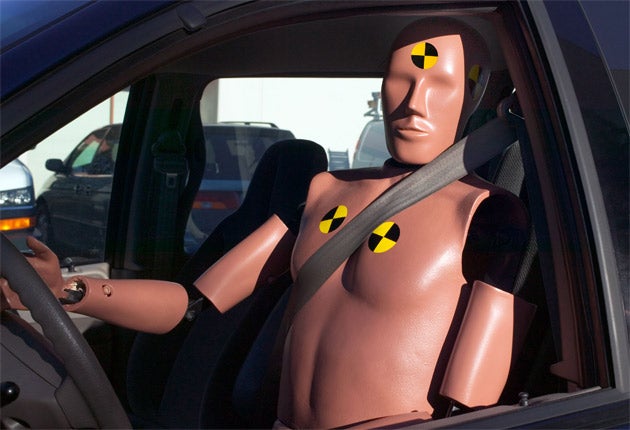Your support helps us to tell the story
From reproductive rights to climate change to Big Tech, The Independent is on the ground when the story is developing. Whether it's investigating the financials of Elon Musk's pro-Trump PAC or producing our latest documentary, 'The A Word', which shines a light on the American women fighting for reproductive rights, we know how important it is to parse out the facts from the messaging.
At such a critical moment in US history, we need reporters on the ground. Your donation allows us to keep sending journalists to speak to both sides of the story.
The Independent is trusted by Americans across the entire political spectrum. And unlike many other quality news outlets, we choose not to lock Americans out of our reporting and analysis with paywalls. We believe quality journalism should be available to everyone, paid for by those who can afford it.
Your support makes all the difference.Crash-test dummies made to test cars for American roads are being made larger and heavier in order to reflect the increasingly obese American body shape.
Humanetics, the only US producer of testing dummies, is rolling out a new version of the testing equipment modelled on a 19-stone (121kgs) person with a body mass index (BMI) of 35.
The US Government’s Centres for Disease Control (CDC) considers this body mass to be “morbidly obese”.
Old-style crash test dummies were modelled around a person with a healthy BMI who weighed around 12 stone (76kgs).
The manufacturer is making the change because seatbelts, airbags, and other safety features modelled to fit a slim person might not work properly for an obese person.
“Typically you want someone in a very tight position with their rear against the back of the seat and the seat belt tight to the pelvis,” Chris O' Connor, CEO of Humanetics, told American television channel ABC.
“An obese person has more mass around midsection and a larger rear which pushes them out of position. They sit further forward and the belt does not grasp the pelvis as easily”.
A 2010 study by the University of Buffalo analysed 150,000 car crashed in the US and determined that morbidly obese drivers are currently 56% more likely to suffer a fatal injury.
Over 70% of Americans are now overweight or obese, according to CDC figures, meaning that adapting safety equipment designs to suit larger bodies could have positive effects for most Americans.
“We need to find a way to make cars safer for everyone, regardless of size,” Mr O’Connor said.
The new dummies will begin testing by the end of this year.
Subscribe to Independent Premium to bookmark this article
Want to bookmark your favourite articles and stories to read or reference later? Start your Independent Premium subscription today.

Join our commenting forum
Join thought-provoking conversations, follow other Independent readers and see their replies
Comments